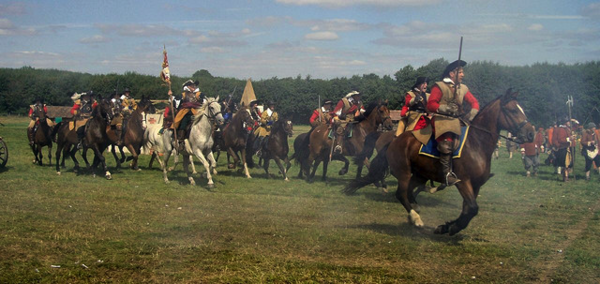Soldiers in the English Civil War
When the English Civil War began in 1642, none the soliders engaged in the battles were professional soldiers. However, by the time the war ended in 1651, the concept of ensuring there was consistently a well-trained, professional army available, along with a collection of skillgful and knowledgeable officers, had firmly taken hold. According to many historians, including Martyn Bennet, the soldiers of the New Model Army were the first examples of the modern professional soldiers who are salaried by the army today.
At the start of the English Civil War, army forces had to be raised from across the country in specific localities, and were led by a local nobleman who was already presiding over the area. The funding of these forces was completely local, with landowners who were unable to fight expected to provide financial donations to ensure the army could be trained and maintained. While this provided enough initial funding to build an army, it didn't work in the long term and proved to be an incredibly unreliable means of ensuring army upkeep.
With funding scarce and many areas struggling to meet the demands of the English Civil War, soldiers were expected to pay for their own weapons and uniform. The 'colours' of each groups of soldiers was chosen by the person or collective who commanded them and was displayed via a sash that would identify them. For example, Lord Brooke’s foot unit wore purple.
One problem with this was that the low level of funding meant economic spending was crucial. Red was a very cheap dye and so was often used by both armies, which created significant confusion on the battelfield. As the New Model Army was introduced, the colours were standardised and army troops were all dressed in Venice red uniforms.

The most common type of soldier during the English Civil War was the foot soldier, who was part of a foot regiment. Typically, each regiment would have been made up of 1,300 men and would be divided into 10 companies of 130 men each.
However, one of the biggest problems facing the civil war was disertion; without the New Model Army to provide more standardised pay and benefits the soldiers were reluctant to remain and fight, particularly as very few were able to afford high quality weapons and pikes were often used in place of the more costly but efficient muskets.
Each soldiers would only have been protected by a jerkin of buffalo hide, known at the time as a buff coat. However, there were some pikeman who were provided with armour including a corselet to protect them during close combat. This was not the case for musketeers, who were only provided with a sword for close quarter combat and had no armour at all.
Horse regiments were more than half the size of foot regiments, being made up of just 600 men with their horses. However, the high costs associated with horse regiments meant some only consisted of 100 men, making them significantly weaker than they should have been. Thankfully for the soldiers, they were armed with heavy swords and pistols to provide them with ample opportunity to fight, and they also benefitted from armour including back and breastplates, as well as a buff coat.
Prince Rupert felt horse regiments were incredibly efficient and even developed his own tactic to change the way horse regiments fought in battle. By galloping into the enemy’s front-rank, the horse regiments would cause confusion and break the enemy regiments apart, making it easier for the horse soldiers to attack.
Another popular type of regiment was the dragoon, which would contain both foot and horse soldiers. Their traditional method of battle was to ride wherever they were required to fight and then attack on foot, ensuring they were fresher than traditional foot soldiers and ready for battle.
Artillery also played an important part in battle during the English Civil War. While smaller guns could follow an advancing army, heavier guns were too difficult to move around and were traditionally used in siege warfare. However, artillery was not used to maximum effect during civil war battles due to the fact that they were dispersed rather than placed in a concentrated group. This resulted in minimal impact and prevented them from wiping out entired regiments, as they could have done if placed close together.
See also: English Civil War Glossary
MLA Citation/Reference
"Soldiers in the English Civil War". HistoryLearning.com. 2025. Web.
